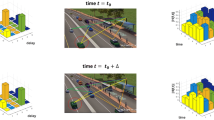Abstract
In this paper, we present a bandwidth efficient non-coherent transceiver design for single input single output orthogonal frequency division multiplexing (SISO-OFDM) modulation with differential encoding. Under fast channel fading or in low signal-to-noise ratio (SNR) regime, pilot assisted channel estimation is not feasible. In such channel conditions, conventional non-coherent detection methods are not reliable resulting in poor throughput. We propose a frequency-spread time-encoded (FSTE) method for OFDM modulation, which exploits multipath diversity and achieves target energy-per-bit to noise spectral density \({E_b}/{N_0}\) in low SNR regime by spreading differentially encoded information symbols along OFDM sub-carriers. We investigate the impact of spreading on bit-error rate (BER) and throughput under relative mobility and multipath fading scenarios. In order to maximize the throughput of the proposed method, we also optimize spreading factor and modulation order. The simulation results demonstrate significant BER and throughput performance gain as compared to prevailing differential encoding methods.








Similar content being viewed by others
References
Proakis, J. G., & Masoud, S. (2007). Digital communications. New York, NY: McGraw-Hill.
Akhtman, Y., Wang, L., Hanzo, L., & Jiang, M. (2010). MIMO-OFDM for LTE, WiFi and WiMAX: Coherent versus non-coherent and cooperative turbo transceivers. Hoboken: Wiley.
Rohling, H., & Engels, V. (1995). Differential amplitude phase shift keying (DAPSK)—A new modulation method for DTVB. In IET International Broadcasting Convention (IBC), Amsterdam, Netherlands, pp. 102–108.
Chennakeshu, S., & Saulnier, G. (1993). Differential detection of pi/4-shifted-DQPSK for digital cellular radio. EEE Transactions on Vehicular Technology, 42(1), 102–108.
Tse, D., & Viswanath, P. (2005). Fundamentals of wireless communication. Cambridge: Cambridge University Press.
Luise, M., Reggiannini, R., & Vitetta, G. M. (1998). Blind equalization/detection for OFDM signals over frequency-selective channels. IEEE Journal on Selected Areas in Communications, 16(8), 1568–1578.
Cherriman, P., Keller, T., & Hanzo, L. (1998). Constant-rate turbo-coded orthogonal frequency division multiplex videophony over UMTS. In Proceedings of IEEE global telecommunications conference (GLOBECOM), Sydney, NSW, pp. 2848–2852.
Lott, M. (1999). Comparison of frequency and time domain differential modulation in an OFDM system for wireless ATM. In Proceedings of IEEE vehicular technology conference (VTC), Houston, TX, pp. 877–883.
Divsalar, D., & Simon, M. K. (1990). Multiple-symbol differential detection of MPSK. IEEE Transactions on Communications, 38(3), 300–308.
Pauli, V., Lampe, L., & Schober, R. (2006). Turbo DPSK using soft multiple-symbol differential sphere decoding. IEEE Transactions on Information Theory, 52(4), 1385–1398.
Novak, R. & Krzymien, W. A. (2005). Diversity combining options for spread spectrum OFDM systems in frequency selective channels. In Proceedings of IEEE conference on wireless communications and networking (WCNC), pp. 308–314).
Tarokh, V., & Jafarkhani, H. (2000). A differential detection scheme for transmit diversity. IEEE Journal on Selected Areas in Communications, 18(7), 1169–1174.
Nam, V. T., Kam, P. Y., & Xin, Y. (2007). LDPC codes with BDPSK and differential detection over flat Rayleigh fading channels. In Proceedings of IEEE global telecommunications conference (GLOBCOM), Washington, DC, pp. 3245–3249.
Hall, E. (1997). Turbo codes for noncoherent channels. In Proceedings of IEEE global telecommunications conference (GLOBECOM), Phoenix, AZ, pp. 0000–0000.
Hewavithana, T. C., & Brookes, M. (2003). Soft decisions for DQPSK demodulation for the Viterbi decoding of the convolutional codes. In Proceedings of IEEE international conference on acoustics speech and signal processing (ICASSP), pp. 04–17.
Ishibashi, K., Ochiai, H., & Kohno, R. (2005). Low-complexity bit-interleaved coded DAPSK for Rayleigh-fading channels. IEEE Journal on Selected Areas in Communications, 23(9), 1728–1738.
Yuan, H., & Kam, P. Y. (2015). On the LLR metrics for DPSK modulations over two-symbol observation intervals for the flat Rician fading channel. IEEE Transactions on Communicaitons, 63(12), 4950–4963.
Nadeem, F., Zia, M., Mahmood, H., Bhatti, N., & Haque, I. (2016). High diversity transceiver for low power differentially encoded OFDM system. ETRI, 38(1), 90–99.
Long Term Evolution of the 3GPP Radio Technology. http:/www.3gpp.org.
Iskander, C. D., & Multisystems H. T. A Matlab-based object-oriented approach to multipath fading channel simulation. In MATLAB central submission. http:/www.mathworks.com.
Zhu, X., & Xue, J. (2006). On the correlation of subcarriers in grouped linear constellation precoding OFDM systems over frequency selective fading. In Proceedings of IEEE vehicular technology conference, Melbourne, VIC, pp. 1431–1435.
Liu, Z., Xin, Y., & Giannakis, G. B. (2003). Linear constellation precoding for OFDM with maximum multipath diversity and coding gains. IEEE Transactions on Communications, 51(3), 416–427.
Wang, X., Wu, H. C., Chang, S. Y., Wu, Y., & Chouinard, J. Y. (2009). Efficient non-pilot-aided channel length estimation for digital broadcasting receivers. IEEE Transactions on Broadcasting, 55(3), 633–641.
Tatsunami, H., Ishibashi, K., & Ochiai, H. (2006). On the performance of LDPC codes with differential detection over Rayleigh fading channels. In Proceedings of IEEE vehicular technology conference, (VTC), Melbourne, Vic, pp. 2388-2392.
Shu, L., Costello, D., & Miller, J. (1984). Automatic repeat request error control schemes. IEEE Communications Magazine, 22(12), 5–14.
Author information
Authors and Affiliations
Corresponding author
Rights and permissions
About this article
Cite this article
Nadeem, F., Zia, M., Mahmood, H. et al. Bandwidth efficient transceiver design for differentially encoded OFDM system. Wireless Netw 24, 709–718 (2018). https://doi.org/10.1007/s11276-016-1362-4
Published:
Issue Date:
DOI: https://doi.org/10.1007/s11276-016-1362-4




